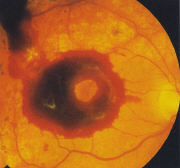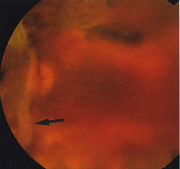


(for a larger retina view click on the picture)
9.1 INDICATIONS FOR VITRECTOMY
Vitrectomy is a specialized procedure which is the domain of
appropriately trained vitreo-retinal surgeons. Vitrectomy is used
to achieve specific goals, which may limit or halt the progress ofadvanced diabetic eye disease. These are:
- to remove vitreous opacity (commonly vitreous haemorrhage,
- to allow completion of panretinal laser photocoagulation (with
- to relieve retinal traction, tractional displacement or ectopia,
- to achieve retinal reattachment by closure of breaks and
- to remove the posterior hyaloid face in some cases of diffuse
also intra-ocular fibrin, or cells) and/or fibrovascular proliferation
(severe extensive proliferative retinopathy; anterior
hyaloidal fibrovascular proliferation)
.
the endolaser, introduced into the vitreous cavity or with the
indirect laser ophthalmoscope), or direct ciliary body laser
photocoagulation
.
traction detachment by removal or dissection of epiretinal
membranes, in cases of non-rhegmatogenous retinal
detachment
.
placement of internal tamponade (in cases of combined traction/
rhegmatogenous detachments)
.
macular oedema with posterior hyaloid face thickening.
.
9.2 VITREOUS / SUBHYALOID HAEMORRHAGE
Simple vitreous haemorrhage is a relative indication for vitreous
surgery, DRS studies have shown that several factors should
considered: the patient's age, the rapidity of progress and degree
of severity of diabetic eye disease, the patient's appreciation of risks
and benefits of surgery, and the patients ability to co-operate with
surgery, and in particular with post-operative positioning, and
supplemental laser photocoagulation where indicated. Various types
of simple vitreous haemorrhage occurs as discussed below:
.
9.2.1 Severe non-clearing vitreous haemorrhage
Vitreous haemorrhage often clears within a matter of days to weeks,
and it is usually possible to achieve delivery of initial or supplemental
panretinal laser photocoagulation without vitrectomy (see section on
lasers). If laser photocoagulation is not possible, or vitreous
haemorrhage persists for more than one month then vitrectomy should
be considered since maculopathy and/or proliferative disease may
progress unchecked, thus compromising the final visual result.
.
Patients with NIDDM are less likely to have severe progressive
proliferative retinopathy and while they also gain benefit from early
surgery, as opposed to deferred surgery (surgery deferred for more
than 6 months) the benefit is less. These patients should nonetheless
have surgery within 3 to 6 months from onset of persistent non-clearing
vitreous haemorrhage.
.
Regular (2-4) weekly ultrasonic examinations are required to ensure
early detection of retinal detachment, and clinical biomicroscopy to
detect iris or iridocorneal angle neovascularization, or haemolytic/ghost
cell glaucoma. Patients with any of these complications should be
considered for early vitrectomy47-49.
a
Surgical goals and procedure
For this indication the surgical goal is to remove the vitreous
opacity through a 3-port pars plana vitrectomy procedure. The
posterior hyaloid face should be removed (this is a structural support
for fibrovascular proliferation and its removal usually prevents
subsequent reproliferation), and initial or supplemental panretinal laser
photocoagulation should be performed to prevent reproliferation,
anterior hyaloidal fibrovascular proliferation, and entry site
complications (fibrovascular ingrowth).
.
9.2.2 Non-clearing post-vitrectomy haemorrhage
Recurrence of vitreous haemorrhage is common in the early post-
vitrectomy period (2-4 weeks) but usually clears spontaneously within a
short time. In all cases where the retina cannot be adequately visualized,
it is essential to confirm the absence of underlying retinal detachment
with ultrasonography. If cavity haemorrhage does not clear within 2-3
weeks, revision surgery should be considered.
.
Surgical goals and procedures
The surgical goal is to remove the haemorrhage, and treat the cause.
Revision normally requires a 3-port pars plana vitrectomy to allow an
adequate internal search for the source of bleeding. In particular,
examination of the previous entry sites is necessary to detect and
treat anterior hyaloidal and/or entry site fibrovascular proliferation.
.
9.2.3 Dense pre-macular haemorrhage
Subhyaloid haemorrhages may be seen with or without associated
intra-gel haemorrhage (Figure 27) these are localized to the immediate
vicinity of neovascular complexes. Most such haemorrhages respond
to supplemental panretinal laser photocoagulation. Dense subhyaloid
haemorrhage occurs in the pre-macular area, in areas of localized
posterior vitreous detachment, or in an existing premacular bursa.
Progressive fibrovascular proliferation develops in non-resolving
pre-macular haemorrhage d involves the cortical vitreous gel with
subsequent macular traction detachment or ectopia.
.
Indications for vitrectomy in this type of haemorrhage include severe
visual loss (for example in only eyes), failure of regression or
resumption of haemorrhage after supplemental laser photocoagulation
the presence of significant subhyaloid pre-macular haemorrhage in eyes
with good pre-existing panretinal laser photocogualtion47-49.
 |
| Figure 27 Subhyaloid haemorrhage occupying the premaulcar bursa space. |
Surgical goals and procedures
A 3-port pars plana vitrectomy is performed taking care to remove the
posterior hyaloid face, particularly from the posterior pole and the
temporal arcades. Haemorrhage is removed, residual membrane
dissected and supplemental panretinal endolaser photocoagulation is
placed if needed. Long standing cases are more likely to require
significant membrane dissection with its attendant risk of iatrogenic
retinal break formation.
.
Some surgeons have suggested that first-line treatment for dense pre-
macular haemorrhages is YAG laser therapy to the pre-hyaloid vitreous
cortex, avoiding the macular area, thus releasing the trapped blood. This
procedure is safe and may allow early visualization of diabetic
maculopathy50-51. This is a promising procedure but is not yet standard
practice and requires further evaluation.
.
9.3 HAEMOLYTIC GHOST-CELL GLAUCOMA
Elevated intraocular pressures may be caused by vitreous haemorrhage
specifically in those eyes with a disrupted anterior hyaloid face after
previous vitrectomy surgery, or in aphakic eyes with vitreous haemorrhage.
"Erythroclasts" pas from the vitreous cavity into the anterior chamber and
obstruct the trabecular meshwork. It is important to differentiate this
condition from steroid induced intra-ocular pressure elevation, since many
of these patients may also be suing topical steroid drops. If the intraocular
pressure remains elevated despite medical therapy after one to 3 weeks,
surgery should be performed.
.
Surgical goals and procedures
Revision pars plana vitrectomy with removal of all vitreous cavity and anterior
chamber haemorrhage is the preferred surgical procedure. Glaucoma filtering
surgery is usually not required.
.
9.4 RETINAL DETACHMENT
9.4.1 Tractional macular ectopia and detachment
Traction retinal ectopia or detachment involving the macula is the leading
indication for vitrectomy surgery in PDR at the present time. Tension is
exerted on the posterior hyaloid face or cortical vitreous remnants, and
indirectly on the retina by contraction of fibrovascular proliferative tissue
resulting in retinal striae, macular ectopia, macular distortion and traction
retinal detachment (Figure 28). Since the hazards of surgery are high in
this condition, vitrectomy is generally limited to those eyes with
a) involvement of the macula; b) evidence of a progressive extra-macular
traction retinal detachment; c) combined traction/rhegmatogenous retinal
detachment which threatens to involve the macula (see below). Surgery
in cases with macular involvement for more than 6 months is usually
associated with little or no functional improvement and is not
recommended49,52,53.
 |
.
Surgical goals and procedures
In addition to removal of media opacity, specific goals include release of
tractional components by removal of fibrovascular membranes, closure of
persistently bleeding vessels and treatment of any iatrogenic retinal breaks.
Cases with pure tractional elevation will experience spontaneous post-operative
retinal reattachment and macular remodelling as a result of successful surgery.
Anatomic success has been reported in between 64% to 80% of patients
(with a 6 month follow-up) with visual function improvement in 26%
to 65%49,52.
.
9.4.2 Combined traction - rhegmatogenous retinal detachment
While most extra-macular traction retinal detachments will remain stable
for many years even if these tissue complexes are highly elevated, in some
patients the force of the fibrovascular traction is sufficient to create a
retinal tear. These tears may also occur in relation to previous laser
photocoagulation scars. These tears are frequently not identified
pre-operatively.
.
Clinically, a rhegmatogenous retinal detachment caused by fibrovascular
proliferation presents with a convex configuration rather than the concave
contour of a tractional, non-rhegmatogenous detached retina. In addition,
white (hydration) lines in the inner retina are more characteristic of a
rhegmatogenous component. Surgery is indicated if there is sudden visual
loss, evidence of progressive peripheral combined traction/rhegmatogenous
retinal detachment, or evidence of progressive iris rubeosis.
.
9.5 SEVERE WIDESPREAD FIBROVASCULAR PROLIFERATION
Some patients (typically young adult type I diabetics with a history of
diabetes since childhood) are seen with a pattern of active fibrovascular
proliferation that progresses despite extensive panretinal laser
photocoagulation. These eyes have a high risk of severe visual loss and
blindness. The Diabetic Retinopathy Vitrectomy Study Group compared
standard laser and vitrectomy indications (with vitrectomy for vitreous
haemorrhage, or traction macular detachment) in a randomized fashion
with early vitrectomy surgery, in total of 370 eyes. The number of
patients experiencing preservation of good visual function (20/40 or better)
was almost twice as high in the early vitrectomy group (44%) compared to
the conventional management group (28%) after 4 years of follow-up.
However, the proportion of eyes with severe visual loss or blindness was
similar in both groups and this stage was reached earlier in the early
vitrectomy group. Clinical characteristics which warrant referral for
vitrectomy, even in the absence of extensive laser photocoagulation,
include widespread fibrovascular proliferation (three disc diameters
or more of fibrovascular tissue).
.
It is to be emphasized that these patients frequently have extensive
proliferation as their sole indication and do not necessarily have vitreous
haemorrhage or macular tractional displacement. While these patients
should receive panretinal laser photocoagulation, the presence of high
risk characteristics should indicate vitreo-retinal referral at an early stage.
.
Surgical goals and procedures
A 3-port pars plana vitrectomy is performed, with great ce being taken
to remove all detectable posterior hyaloid face which is typically adherent
to the retina.
.
9.6 IRIS / ANGLE NEOVASCULARIZATION WITH VITREOUS OPACITY
Anterior segment neovascularization which is mild and non-progressive
may be safely monitored. Progressive iris or angle neovascularization
requires panretinal laser photocoagulation, and if vitreous haemorrhage
prevents adequate and effective retinal laser photocoagulation,
vitrectomy with endolaser photocoagulation is indicated. Patients with
established neovascular glaucoma may undergo combined surgery,
comprising pars plana vitrectomy with extensive endolaser photo-
coagulation and in some cases with additional direct ciliary body
photocoagulation. This surgery is combined with silicone oil exchange
in some eyes or with glaucoma filtration surgery in others.
.
9.7 ANTERIOR HYALOIDAL FIBROVASCULAR PROLIFERATION/
RETROLENTICULAR FIBROVASCULAR PROLIFERATION
Fibrovascular proliferation on the anterior hyaloidal surface or its remnant
is typically seen after vitrectomy in severe ischaEmic eyes of patients with
type 1 diabetes mellitus. This fibrous tissue, which causes contraction of
adjacent tissue and may cause peripheral traction retinal detachment,
posterior iris displacement and lens displacement or recurrent vitreous
haemorrhage, is highly vascular and difficulty to treat. in some patients
this process may be localized to the area of the entry site and is
associated with typical sentinel vessels on the adjacent episclera and
sclera55. Anterior hyaloidal fibrovascular proliferation may also occur
after cataract extraction in patients with active proliferative disease56.
.
Surgical goals and procedure
The surgical goal is to remove all fibrovascular tissue. This requires
basal vitrectomy, lensectomy, membrane dissection and extensive,
confluent laser photocoagulation to the peripheral retina and pars plana,
often combined with scleral buckling surgery and silicone oil exchange.
.